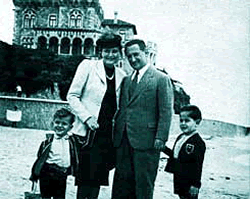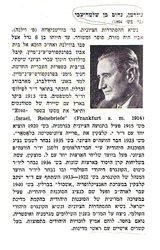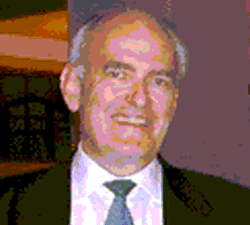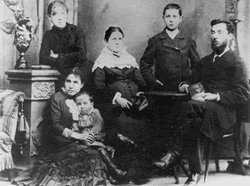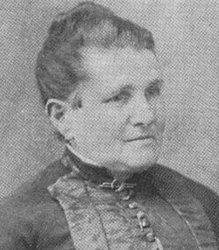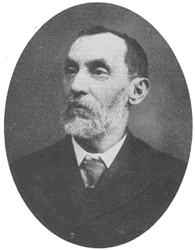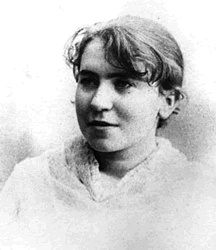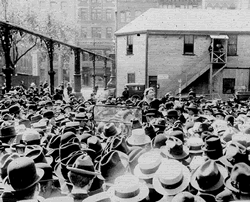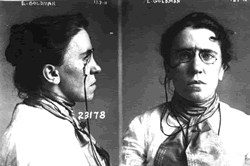Courtesy of New York Public Library Manuscripts and Archives Division and The Emma Goldman Papers
Left to right: Emma, standing; Helena, seated, with Morris on her lap; Taube; Herman; Abraham.
Abraham Goldman, date unknown
Courtesy of The Emma Goldman Papers and International Institute of Social History
Emma Goldman (1869-1940)Born to Taube Bienowitch and Abraham Goldman
in the Jewish quarter of in Kovno, Russian city in (now) Lithuania
in Lithuania, 27 June 1869, Goldman experienced a traumatic youth. She
grew up in a family providing little love, her parents the product of
an arranged marriage. Abraham invested the little money they had in
a business that failed, leaving a family of seven with little to live
on.
Abraham sent Emma to Germany to live with her grandmother and attend
school. Her uncle ended up withdrawing her from the school and pocketed
the tuition sent from her father.
She returned home and enrolled in school. Many of her teachers were
cruel to her as well. The religious instructor would severely discipline
the children by flailing students palms with a ruler. Emma talked back
to him, resulting in ill feelings between the two. One of the geography
teachers would punish the girls in a different way. Instead of hitting
them, after class he would touch them in improper ways. In the middle
of class, Emma yelled at him for doing this when all the other girls
were afraid to speak up. Emma was considered a troublemaker by many
of the teachers because she would do what she wanted. If she felt that
the teacher was asking for something that was unjust and unfair, then
she refused to comply.
Emma did have a favorite teacher at school. Her German teacher provided
much after hours help to her, allowing her into her house, reading German
novels to her. She encouraged Emma to take up French and reading more
literature. Emma completed three and a half years at this school. She
was offered a chance to attend the high school. She studied diligently
and easily passed the entrance exam. The only remaining requirement
was a satisfactory recommendation from her religious instructor, the
same that thought of Emma as a troublemaker with no respect for authority.
(Alix Shulman To the Barricades: The Anarchist Life of Emma Goldman,
p 20) With no chance for admission to the high school, Emma travels
with her family to St. Petersburg, Russia
Russian society for the working class was progressively growing worse.
Czar Alexander II was assassinated 1 March 1881 by Nihilists, hoping
for a Russian revolution and overthrow of the government. The movement
failed and Alexander III began an even more oppressing rule, vowing
to crush all revolutionary activity and destroy all radical opinion
of every kind. (Shulman, p 24) Jews were blamed for the assassination
and targeted for severe oppression. The government searched for any
radical movements in order to squelch any revolutions before they started.
Books, journals, and papers were banned and censored. Emma studied in
school, reading Russian literature and slowly learning more about the
terrible social injustices around her. Her and her older sister, Helena,
finally flee the country for America in December 1885.
Goldman entered a new country where she assumed that she had escaped
the traditional barriers to women's freedom so pervasive in the old
world. She settled with relatives in 1885 in Rochester, New York. Sadly
she discovered that family life in the Jewish ghetto of Rochester and
piecework in the textile factory did not differ significantly from what
she had left behind in Russia. Asserting her new freedom in intimate
life in America, Goldman soon fell in love with a co-worker and chose
to marry him.
In early May 1886, workers strike for an eight-hour workday. On 4 May
at a gathering of workers in Chicago’s Haymarket Square, a bomb
is thrown, killing seven police officers. A number of “anarchists
and organizers of the event are held responsible (Candace Falk Emma
Goldman: A Guide to Her Life and Documentary Sources p 2) and executed.
Goldman was so moved by the hanging that it was like a religious conversion.
For the rest of her life, she would remember that Black Friday as the
day of her social awakening, and the martyred men as the most decisive
influence of my existence. (Shulman p 46) She had found her new position
in life, answering the call of the young girls in Russia and all over
the world that had to endure injustices as she had. She had found real
revolutionaries to admire instead of merely characters in a book. She
could not only think as and support the anarchists, but also had to
act on her feelings. From that point on, Emma Goldman energetically
dedicated her life to fighting, like the Haymarket martyrs, for anarchism.
(Shulman p 48)
Many people do not know exactly what the anarchists advocate. Shulman
defines anarchism as:
A political and social system opposed to all forms of government based
on force. An anarchist society would have no laws, no lawmakers, no
officials, no police, no armies, no institutions, or even any customs
or traditions that people would be forced to obey against their will.
(P 50)
Opponents claimed that an anarchic society would be chaotic without
government order and law. Without limitations on people’s actions
there would be the increased injustices, with the strong stealing from
the weak and helpless. Anarchists claim that people are inherently good
and given the absence of forcible law and order, would make the choice
that is beneficial to the majority. Taking into account Goldman’s
childhood, this would seem logical. People who had been repressed by
the few elite in control over the government would be sympathetic to
others being tormented by similar forces.
With the crystallization of Goldman's political ideas came changes in
her personal life. Risking the stigma of divorce, Goldman left her husband
and headed for a new life, first in New Haven, then in New York City.
Within a year she was living in a commune with other Russian-born anarchists,
including her first great love and eventual life-long comrade, Alexander
Berkman. The twenty-year-old idealist soon became a prominent member
of New York City's immigrant anarchist community
Goldman begins to read much anarchist literature regularly, and becomes
friends with publishers of anarchist papers. She begins to meet with
prominent Russian socialists and anarchists and attends lectures. On
15 August 1889, Emma travels to New York City and meets the editor of
Die Freiheit, an anarchist publication. She begins support work at the
office of the publication and helps organize the second anniversary
memorial of those hung for the Haymarket Square bombing. In January
of 1890, the editor plans for Goldman to go on a lecture tour, addressing
the limitations of the eight-hour movement. (Falk p 3) She finds that
she has a real talent as an orator, and decides to use this talent to
spread her political opinions.
Goldman begins to travel all over New England giving speeches ranging
in topics from the Paris Commune, 1871, to The Right To Be Lazy. Speaking
mostly in German, sometimes in Yiddish, to groups, Emma encourages workers
to join unions and strike for better working conditions. She also organized
anarchist educational and social groups for German, Russian, and Jewish
immigrants. (Falk p 3) She spoke to groups such as the International
Working People’s Association, the Workingmen’s Educational
Society, Pioneers of Liberty, and the International Workingmen’s
Association. Goldman marched with the Working Women’s Society in
New Yorks May Day Parade on 1 May 1891. She addressed judicial issues
concerning anarchists that had been arrested. At times, Emma wishes
to return to Russia to combat the system of government there under Czar
Alexander III.
On 21 August 1893, Goldman leads a march to Union Square, where she
advocated the right to take bread if [workers] are hungry, and to demonstrate
their needs before the palaces of the rich. (Falk p 5) Ten days later,
Goldman is arrested for incitement to riot. She is found guilty of aiding
and abetting an unlawful assemblage, and is sentenced to Blackwell’s
Island penitentiary for one year, serving ten months.
Emma learned much in prison, reading much German and English literature.
She made many friends, revolutionaries and anarchists. Prison mates
admired her for standing up to authority, namely when she refused to
force the prison sewing shop to work harder, comparing it to a slave
driver. Even the warden admired her for her trustworthiness, honesty,
and good principles, calling her a model prisoner. (Shulman, p 101)
Reflecting on her stay in prison, Goldman thankfully says that it has
changed none of my old sentiments; on the contrary, it has made them
more ardent, more absolute than ever, and henceforward all that remains
to me of life can be summed up in one word: liberty. (Shulman, p 103)
Upon her release from prison, Goldman resolves ton hold more lectures
in English in order to preach to the ever-growing numbers of American
radicals. She travels back to Europe to speak, finding the freedoms
of speech in England very inviting. When she returns to America, she
travels west and gives lectures in California, Oregon, Washington, Colorado,
and other states. Subjects for her speeches included What is Anarchism?
The Women in the Present and Future, Free Love, The Aim of Humanity
and Woman, Marriage, and Prostitution. (Falk, p 11)
After the assassination of President McKinley in September 1901, Goldman
was immediately linked to the crime when the assassin proclaimed that
he was an anarchist. By this time Goldman had earned the reputation
of America’s best-known anarchist. Of course, no connection could
be established since there was none, and Emma was released. Ironically,
Emma was the only person to stand up for the rights of the assassin.
She called for others to aid in his defense, but not even other anarchists
helped. She was so disgusted with the reaction that “for
a time she withdrew completely from the movement.” (Shulman, p
127) Eventually, answering the repressive cries from Russia, she begins
to make speeches again and organize movements. Working under an assumed
name, Goldman organized the Free Speech League, reaching many different
reform and radical groups.
for the rest go to http://recollectionbooks.com/bleed/Encyclopedia/GoldmanEmma/goldmanWright.htm
Courtesy of The Library of Congress - Prints and Photographs Division and The Emma Goldman Papers
